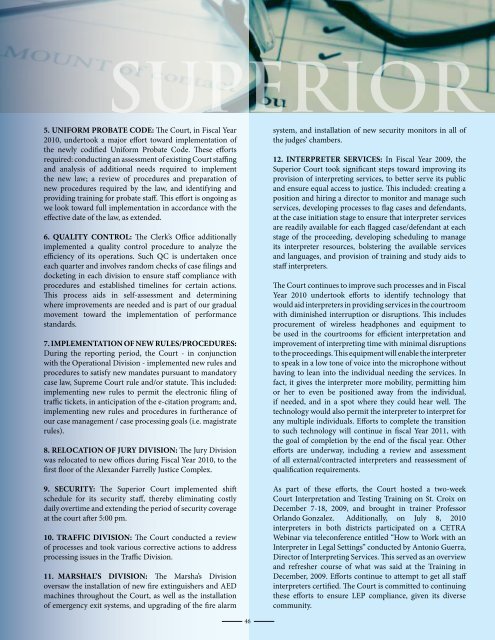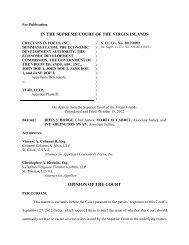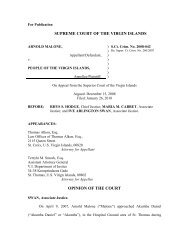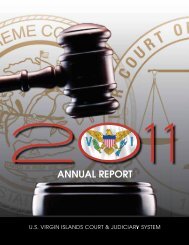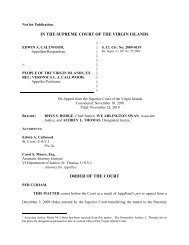2010 Annual Report - Supreme Court of the Virgin Islands
2010 Annual Report - Supreme Court of the Virgin Islands
2010 Annual Report - Supreme Court of the Virgin Islands
You also want an ePaper? Increase the reach of your titles
YUMPU automatically turns print PDFs into web optimized ePapers that Google loves.
5. UNIFORM PROBATE CODE: The <strong>Court</strong>, in Fiscal Year<br />
<strong>2010</strong>, undertook a major effort toward implementation <strong>of</strong><br />
<strong>the</strong> newly codified Uniform Probate Code. These efforts<br />
required: conducting an assessment <strong>of</strong> existing <strong>Court</strong> staffing<br />
and analysis <strong>of</strong> additional needs required to implement<br />
<strong>the</strong> new law; a review <strong>of</strong> procedures and preparation <strong>of</strong><br />
new procedures required by <strong>the</strong> law, and identifying and<br />
providing training for probate staff. This effort is ongoing as<br />
we look toward full implementation in accordance with <strong>the</strong><br />
effective date <strong>of</strong> <strong>the</strong> law, as extended.<br />
6. QUALITY CONTROL: The Clerk’s Office additionally<br />
implemented a quality control procedure to analyze <strong>the</strong><br />
efficiency <strong>of</strong> its operations. Such QC is undertaken once<br />
each quarter and involves random checks <strong>of</strong> case filings and<br />
docketing in each division to ensure staff compliance with<br />
procedures and established timelines for certain actions.<br />
This process aids in self-assessment and determining<br />
where improvements are needed and is part <strong>of</strong> our gradual<br />
movement toward <strong>the</strong> implementation <strong>of</strong> performance<br />
standards.<br />
7. IMPLEMENTATION OF NEW RULES/PROCEDURES:<br />
During <strong>the</strong> reporting period, <strong>the</strong> <strong>Court</strong> - in conjunction<br />
with <strong>the</strong> Operational Division - implemented new rules and<br />
procedures to satisfy new mandates pursuant to mandatory<br />
case law, <strong>Supreme</strong> <strong>Court</strong> rule and/or statute. This included:<br />
implementing new rules to permit <strong>the</strong> electronic filing <strong>of</strong><br />
traffic tickets, in anticipation <strong>of</strong> <strong>the</strong> e-citation program; and,<br />
implementing new rules and procedures in fur<strong>the</strong>rance <strong>of</strong><br />
our case management / case processing goals (i.e. magistrate<br />
rules).<br />
8. RELOCATION OF JURY DIVISION: The Jury Division<br />
was relocated to new <strong>of</strong>fices during Fiscal Year <strong>2010</strong>, to <strong>the</strong><br />
first floor <strong>of</strong> <strong>the</strong> Alexander Farrelly Justice Complex.<br />
9. SECURITY: The Superior <strong>Court</strong> implemented shift<br />
schedule for its security staff, <strong>the</strong>reby eliminating costly<br />
daily overtime and extending <strong>the</strong> period <strong>of</strong> security coverage<br />
at <strong>the</strong> court after 5:00 pm.<br />
10. TRAFFIC DIVISION: The <strong>Court</strong> conducted a review<br />
<strong>of</strong> processes and took various corrective actions to address<br />
processing issues in <strong>the</strong> Traffic Division.<br />
11. MARSHAL’S DIVISION: The Marsha’s Division<br />
oversaw <strong>the</strong> installation <strong>of</strong> new fire extinguishers and AED<br />
machines throughout <strong>the</strong> <strong>Court</strong>, as well as <strong>the</strong> installation<br />
<strong>of</strong> emergency exit systems, and upgrading <strong>of</strong> <strong>the</strong> fire alarm<br />
system, and installation <strong>of</strong> new security monitors in all <strong>of</strong><br />
<strong>the</strong> judges’ chambers.<br />
12. INTERPRETER SERVICES: In Fiscal Year 2009, <strong>the</strong><br />
Superior <strong>Court</strong> took significant steps toward improving its<br />
provision <strong>of</strong> interpreting services, to better serve its public<br />
and ensure equal access to justice. This included: creating a<br />
position and hiring a director to monitor and manage such<br />
services, developing processes to flag cases and defendants,<br />
at <strong>the</strong> case initiation stage to ensure that interpreter services<br />
are readily available for each flagged case/defendant at each<br />
stage <strong>of</strong> <strong>the</strong> proceeding, developing scheduling to manage<br />
its interpreter resources, bolstering <strong>the</strong> available services<br />
and languages, and provision <strong>of</strong> training and study aids to<br />
staff interpreters.<br />
The <strong>Court</strong> continues to improve such processes and in Fiscal<br />
Year <strong>2010</strong> undertook efforts to identify technology that<br />
would aid interpreters in providing services in <strong>the</strong> courtroom<br />
with diminished interruption or disruptions. This includes<br />
procurement <strong>of</strong> wireless headphones and equipment to<br />
be used in <strong>the</strong> courtrooms for efficient interpretation and<br />
improvement <strong>of</strong> interpreting time with minimal disruptions<br />
to <strong>the</strong> proceedings. This equipment will enable <strong>the</strong> interpreter<br />
to speak in a low tone <strong>of</strong> voice into <strong>the</strong> microphone without<br />
having to lean into <strong>the</strong> individual needing <strong>the</strong> services. In<br />
fact, it gives <strong>the</strong> interpreter more mobility, permitting him<br />
or her to even be positioned away from <strong>the</strong> individual,<br />
if needed, and in a spot where <strong>the</strong>y could hear well. The<br />
technology would also permit <strong>the</strong> interpreter to interpret for<br />
any multiple individuals. Efforts to complete <strong>the</strong> transition<br />
to such technology will continue in fiscal Year 2011, with<br />
<strong>the</strong> goal <strong>of</strong> completion by <strong>the</strong> end <strong>of</strong> <strong>the</strong> fiscal year. O<strong>the</strong>r<br />
efforts are underway, including a review and assessment<br />
<strong>of</strong> all external/contracted interpreters and reassessment <strong>of</strong><br />
qualification requirements.<br />
As part <strong>of</strong> <strong>the</strong>se efforts, <strong>the</strong> <strong>Court</strong> hosted a two-week<br />
<strong>Court</strong> Interpretation and Testing Training on St. Croix on<br />
December 7-18, 2009, and brought in trainer Pr<strong>of</strong>essor<br />
Orlando Gonzalez. Additionally, on July 8, <strong>2010</strong><br />
interpreters in both districts participated on a CETRA<br />
Webinar via teleconference entitled “How to Work with an<br />
Interpreter in Legal Settings” conducted by Antonio Guerra,<br />
Director <strong>of</strong> Interpreting Services. This served as an overview<br />
and refresher course <strong>of</strong> what was said at <strong>the</strong> Training in<br />
December, 2009. Efforts continue to attempt to get all staff<br />
interpreters certified. The <strong>Court</strong> is committed to continuing<br />
<strong>the</strong>se efforts to ensure LEP compliance, given its diverse<br />
community.<br />
46


